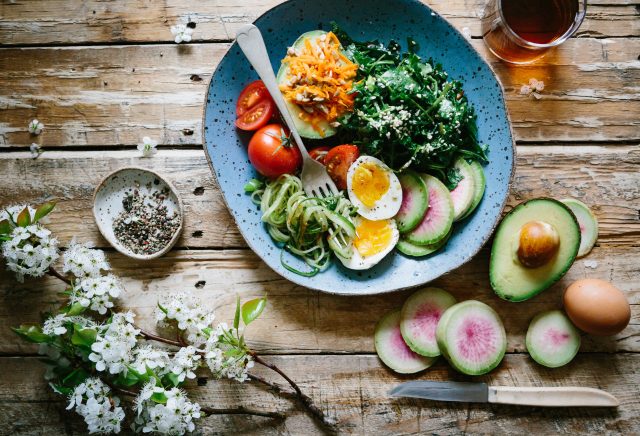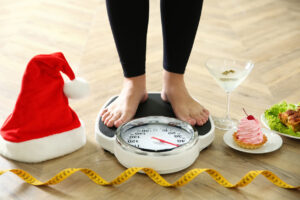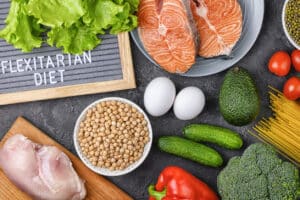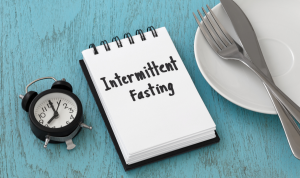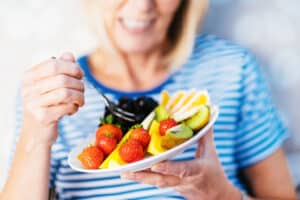Tell me if this sounds familiar: You are thoughtful about your nutrition. Perhaps you even consider yourself an expert — or at least an enthusiast. But you are not happy with your weight, body composition, and/or your relationship to food. You think: If only I could eat the way I should eat, I would be healthier and happier. You’re definitely not alone. That’s why I’m here to share the best nutritional advice for women over 50.
What if the way you “should” eat is different than what you’ve been taught? Our relationship to food is deep seated and ingrained in us from an early age. If your role model — mom, aunt, grandmother, sister, friend, or maybe even a model in your favorite magazine — had a disordered relationship with food you are likely to have one too.
My mom and my aunt were serial dieters and never satisfied with their weight; every Monday brought a new push to be “good” on their diet, and within days they “blew it” and the diet went out the window. I went on my first diet in junior high, and spent decades of wasted energy and money struggling with food and never feeling good enough because my self-worth was tied up in my food and weight story.
If this resonates with you, it’s time to claim a new, more nurturing eating philosophy for the prime of your life: Food Freedom. It’s truly the best nutritional advice for women over 50.
Recognize disordered eating patterns
Eating compulsively, binging and/or white knuckling it to be “good” are all signs of disordered eating. If guilt and shame are your constant dining companions, it’s time to invite better guests. Our bodies have innate natural hunger and satiety signals that support intuitive eating. These signals can get jammed by chronic dieting and highly-processed foods — and toxic stress as well.
Visualize the kind of eater you would like to be
Imagine trusting and working in harmony with your body to eat more intuitively. You likely know someone who radiates health and vitality, who eats nutrient-dense whole foods, and doesn’t obsess about what they’re eating (or not eating). They are in flow with life and the nourishment that keeps them flourishing. When they have a dessert, it’s of high quality, and they enjoy every bite. Picture that for yourself, and practice it in your mind.
Food and culture writer Micheal Pollan says that when he grew up, dessert was not an everyday affair. It was enjoyed occasionally such as for the Sabbath or a birthday—and it was always homemade with wholesome ingredients and love and consumed with joy.
Stop dieting
Calorie-restrictive diets and yo-yo dieting make you fat. If you still think that weight loss is a function of calories in/calories out, think again. That old paradigm is based on physics or energy, but it leaves out the biochemical aspect of weight loss — hormones. When you starve yourself, your body will do all it can to preserve its weight to survive the famine. That’s why we march back up the scale after weight loss — and each time it gets more difficult to march back down.
When your body feels safe and nourished at a cellular level, it will release weight. That’s when you’ll feel the difference between losing weight by dieting and releasing weight because your body and emotions no longer need it to feel safe.
Kick the sugar addiction
Eating sugar on a regular basis is toxic; it raises your risk of heart disease, diabetes, cancer, and Alzheimer’s. If the thought of giving up sugar seems insurmountable, that’s because sugar is highly addictive — even more addictive than opioids.
If you only remember one thing from this article, let this be it: a benign amino acid supplement called glutamine can help you kick the sugar habit in a matter of minutes. Really. You may have heard of the gut/brain connection. If you crave sugar, it’s likely that you have opportunistic bad bacteria in your gut that signal to your brain to eat sugar. Another Glutamine I recommend is Innate Response’s GI Response.
Glutamine is a gut healing amino acid that tricks your body into thinking it’s getting sugar. It also contributes to healing your stomach lining; the intestine is highly regenerative, shedding its lining every five to seven days. Take 1,000 milligrams of glutamine every four hours as needed; experiment with it to see what works best for you.
Once your brain isn’t so preoccupied with getting its next sugar (or other simple carb) fix, you’ll have better access to the executive functioning of your prefrontal cortex. And you can make better food choices.
The best nutritional advice for women over 50: Eat real food
One of the most important books I’ve ever read is Real Food: What to Eat and Why by Nina Planck. If you suffer from disordered eating, read this book; you’ll find it illuminating.
I grew up in the 1970s and ‘80s during a perfect storm that created a catalyst for disordered eating and the current obesity epidemic:
- Fats were vilified;
- The government’s 1977 food pyramid had grains as its foundation (which often cause blood sugar spikes and crashes); and
- Processed food and fast food companies started their campaigns to hook consumers on their faux food, taking their lead from the addiction-inducing tactics of the tobacco companies.
When you’re ready for some science-based, body-loving guidance about what to eat, download the Institute for Functional Medicine’s Core Food Plan.
Ritualize your meal time
When you eat in a relaxed state — not working or in the car or watching television or having a contentious discussion — your body goes into a parasympathetic state, which is a state of relaxation. This will determine a lot about how your body digests food and assimilates the nutrients from that food.
Set the table, play soothing music, say a blessing of gratitude for the people along the way that made this meal possible for you, and the people with whom you break bread. Enjoy your food with all of your senses. Pay attention to how your body feels as you eat. This may be new for you, but it’s a giant leap forward toward the food freedom you seek.
May you discover a joy in eating — without confusion, shame or guilt — and the energy and vitality that come from intuitive eating and an abundance of delicious, nutrient-dense foods.
What now?
Learn more about how to eliminate your food cravings by taking the Craving Type Questionnaire, and reading The Craving Cure: Identify Your Craving Type to Activate Your Natural Appetite Control by Julia Ross. She is a pioneer in the use of amino acids to overcome addiction. If you have a friend or loved one with an addiction issue, look further into Julia’s work in those areas.
Now that we’ve covered some great nutritional advice for women over 50, let’s talk about the three secrets to aging well.

